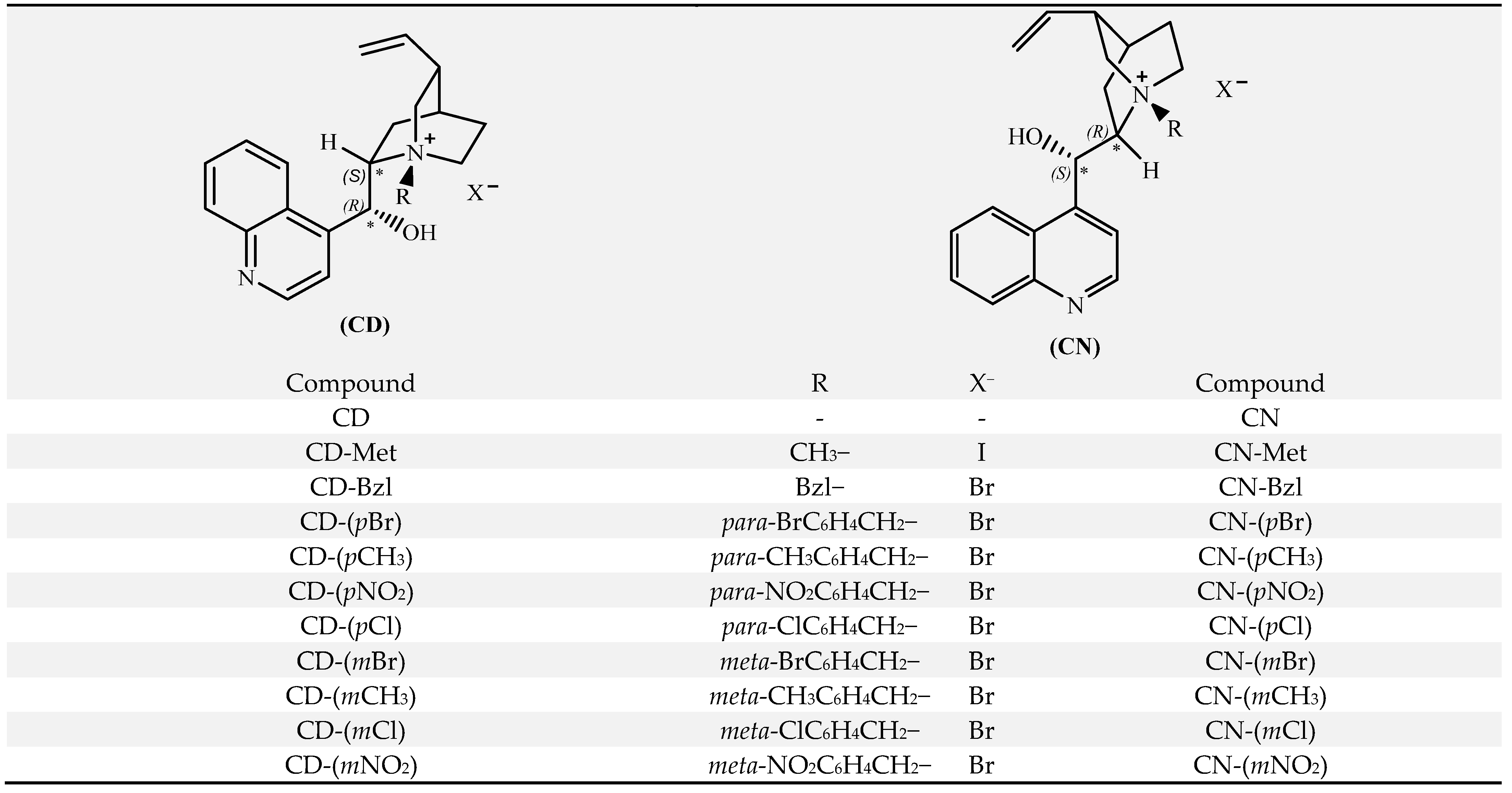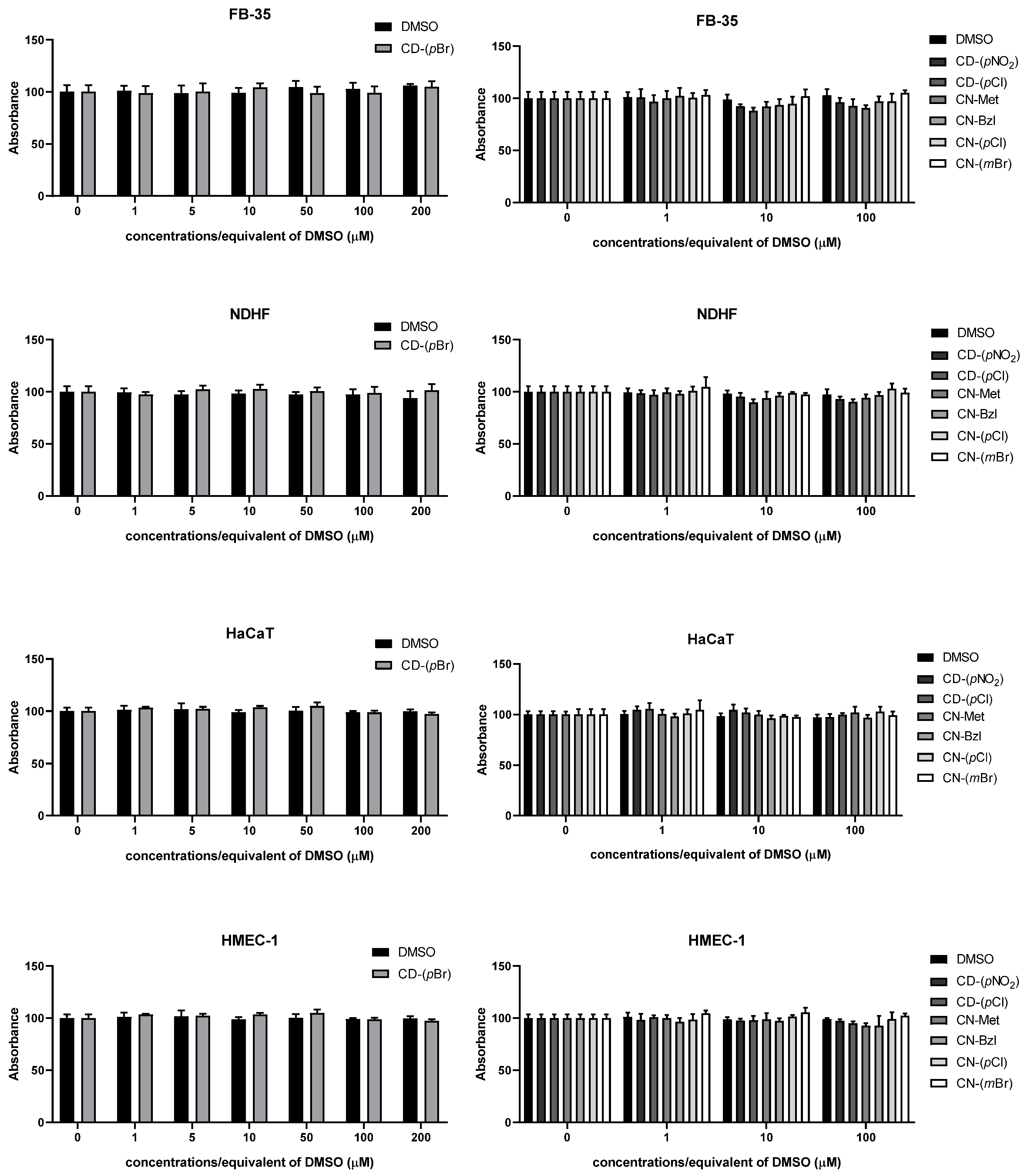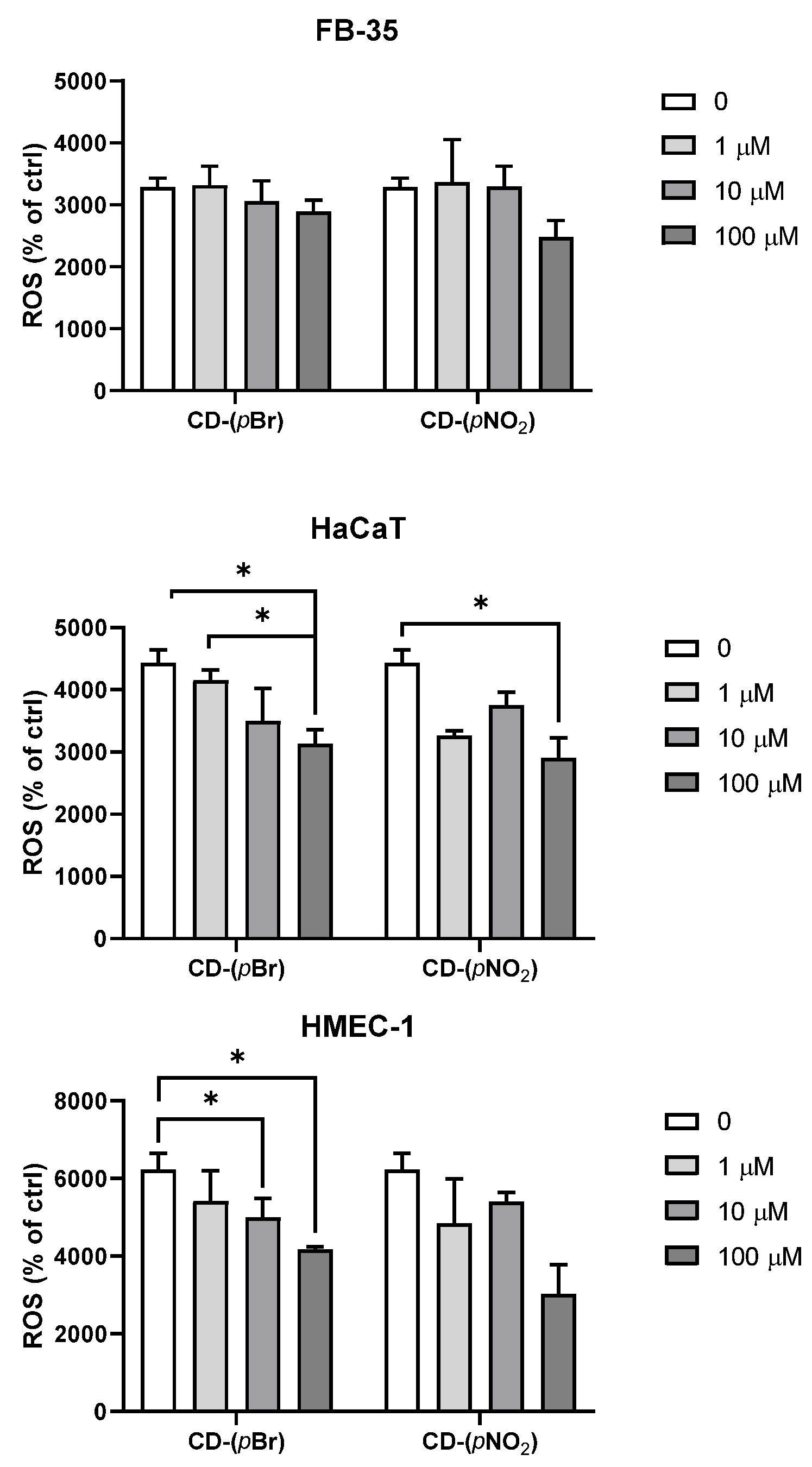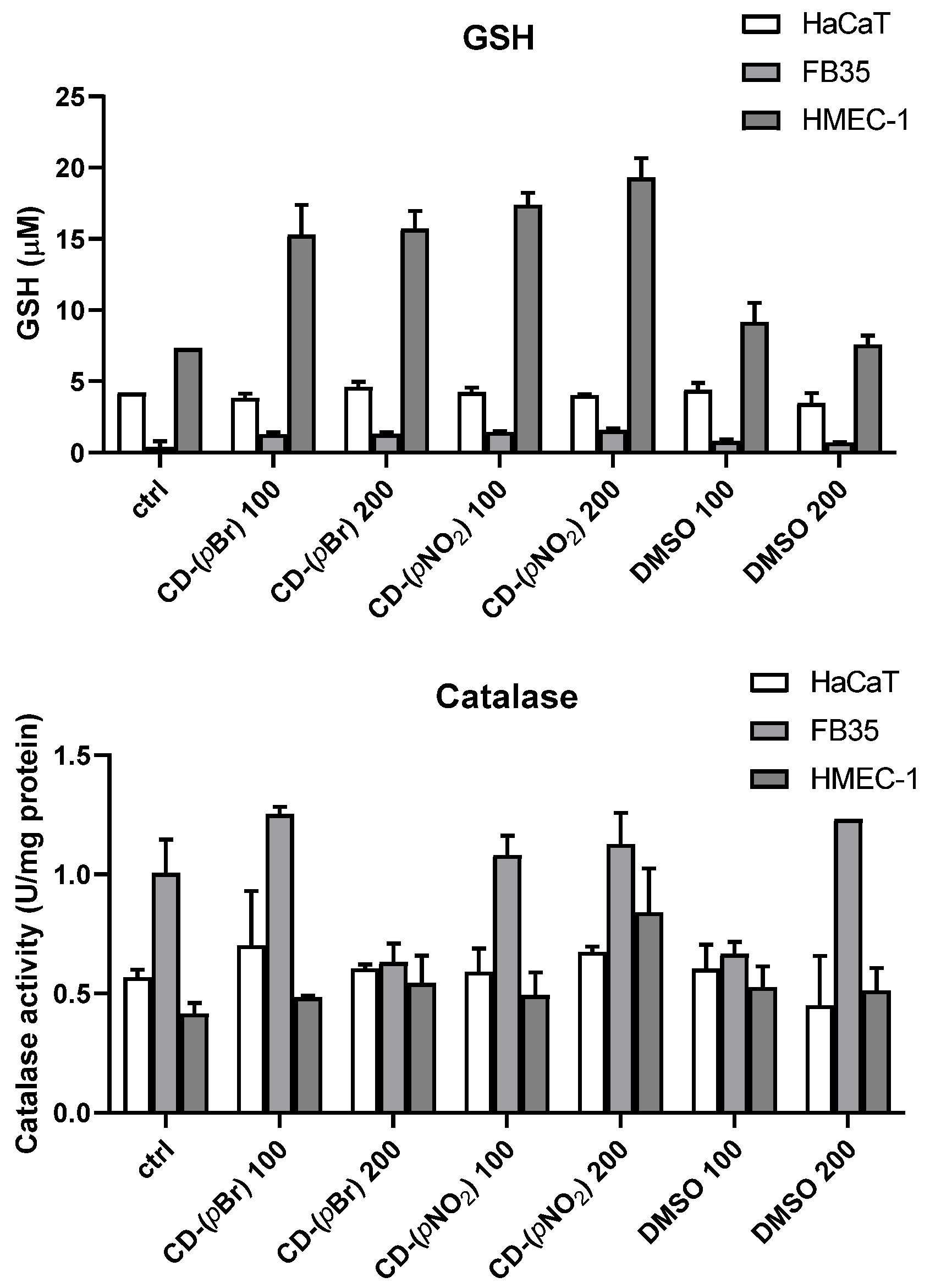Antimicrobial Activity of Quasi-Enantiomeric Cinchona Alkaloid Derivatives and Prediction Model Developed by Machine Learning
Abstract
1. Introduction
2. Materials and Methods
2.1. Synthesis of Quaternary Derivatives
2.2. Antimicrobial Activity
2.3. MTT
2.4. Measurement of ROS, GSH and Catalase Activity
2.5. Statistics
2.6. Principal Component Analysis
2.7. Sampling of the Potential Energy Surfaces
2.8. Machine Learning Multivariate Linear Regression
3. Results and Discussion
3.1. Synthesis
3.2. Antimicrobial Activity
3.3. Cytotoxicity
3.4. Effects of the Compounds on Cellular Reactive Oxygen Species and Antioxidative Defense
3.5. PCA Analysis and Activity/PES Model
4. Conclusions
Author Contributions
Funding
Institutional Review Board Statement
Informed Consent Statement
Data Availability Statement
Acknowledgments
Conflicts of Interest
References
- CDC. Antibiotic Resistance Threats in the United States, 2019; Department of Health and Human Services, CDC: Atlanta, GA, USA, 2019.
- European Centre for Disease Prevention and Control. Available online: https://www.ecdc.europa.eu/en/home (accessed on 4 November 2020).
- Thawabteh, A.; Juma, S.; Bader, M.; Karaman, D.; Scrano, L.; Bufo, S.A.; Karaman, R. The biological activity of natural alka-loids against herbivores, cancerous cells and pathogens. Toxins 2019, 11, 656. [Google Scholar] [CrossRef] [PubMed]
- Wang, H. Chiral phase-transfer catalysts with hydrogen bond: A powerful tool in the asymmetric synthesis. Catalysts 2019, 9, 244. [Google Scholar] [CrossRef]
- Song, C.E. Cinchona Alkaloids in Synthesis and Catalysis: Ligands, Immobilization and Organocatalysis; Wiley-VCH: Weinheim, Germany, 2009. [Google Scholar]
- Ilisz, I.; Bajtai, A.; Lindner, W.; Péter, A. Liquid chromatographic enantiomer separations applying chiral ion-exchangers based on Cinchona alkaloids. J. Pharm. Biomed. Anal. 2018, 159, 127–152. [Google Scholar] [CrossRef] [PubMed]
- Achan, J.; Talisuna, A.O.; Erhart, A.; Yeka, A.; Tibenderana, J.K.; Baliraine, F.N.; Rosenthal, P.J.; D’Alessandro, U. Quinine, an old anti-malarial drug in a modern world: Role in the treatment of malaria. Malar. J. 2011, 10, 12. [Google Scholar] [CrossRef] [PubMed]
- Skiera, I.; Antoszczak, M.; Trynda, J.; Wietrzyk, J.; Boratyński, P.; Kacprzak, K.; Huczyński, A. Antiproliferative activity of polyether antibiotic—Cinchona alkaloid conjugates obtained via click chemistry. Chem. Biol. Drug Des. 2015, 86, 911–917. [Google Scholar] [CrossRef]
- Kacprzak, K.; Ruszkowski, P.; Valentini, L.; Huczynski, A. Cytotoxic and trypanocidal activities of cinchona alkaloid derivatives. Chem. Biol. Drug Des. 2018, 92, 1778–1787. [Google Scholar] [CrossRef]
- Che, Z.P.; Yang, J.M.; Zhang, S.; Sun, D.; Tian, Y.E.; Liu, S.M.; Lin, X.M.; Jiang, J.; Chen, G.Q. Synthesis of novel 9R/S-acyloxy derivatives of cinchonidine and cinchonine as insecticidal agents. J. Asian Nat. Prod. Res. 2020, 23, 1–13. [Google Scholar] [CrossRef]
- Qi, Y.; Pradipta, A.R.; Li, M.; Zhao, X.; Lu, L.; Fu, X.; Wei, J.; Hsung, R.P.; Tanaka, K.; Zhou, L. Cinchonine induces apoptosis of HeLa and A549 cells through targeting TRAF6. J. Exp. Clin. Cancer Res. 2017, 36, 35. [Google Scholar] [CrossRef]
- Jo, Y.J.; Lee, H.I.; Kim, N.; Hwang, D.; Lee, J.; Lee, G.R.; Hong, S.E.; Lee, H.; Kwon, M.; Kim, N.Y.; et al. Cinchonine inhibits osteoclast differentiation by regulating TAK1 and AKT, and promotes osteogenesis. J. Cell. Physiol. 2021, 236, 1854–1856. [Google Scholar] [CrossRef]
- Foley, D.J.; Zinken, S.; Corkery, D.; Laraia, L.; Pahl, A.; Wu, Y.W.; Waldmann, H. Phenotyping reveals targets of a pseudo-natural-product autophagy inhibitor. Angew. Chem. Int. Ed. 2020, 132, 12570–12576. [Google Scholar] [CrossRef]
- Latorre-Sánchez, A.; Johansson, M.; Zhang, Y.; Malkoch, M.; Pomposo, J.A. Active quinine-based films able to release antimicrobial compounds via melt quaternization at low temperature. J. Mater. Chem. B. 2018, 6, 98–104. [Google Scholar] [CrossRef]
- Burckhardt, I.; Panitz, J.; Burckhardt, F.; Zimmermann, S. Identification of Streptococcus pneumoniae: Development of a standardized protocol for optochin susceptibility testing using total lab automation. BioMed Res. Int. 2017, 2017, 4174168. [Google Scholar] [CrossRef] [PubMed]
- Wang, X.; Zeng, Y.; Sheng, L.; Larson, P.; Liu, X.; Zou, X.; Wang, S.; Guo, K.; Ma, C.; Zhang, G.; et al. A Cinchona alkaloid antibiotic that appears to target ATP synthase in Streptococcus pneumoniae. J. Med. Chem. 2019, 62, 2305–2332. [Google Scholar] [CrossRef] [PubMed]
- Bosak, A.; Ramić, A.; Šmidlehner, T.; Hrenar, T.; Primožič, I.; Kovarik, Z. Design and evaluation of selective butyrylcholinesterase inhibitors based on Cinchona alkaloid scaffold. PLoS ONE 2018, 13, e0205193. [Google Scholar] [CrossRef] [PubMed]
- Skočibušić, M.; Odžak, R.; Smolić, T.; Hrenar, T.; Primožič, I. Novel Imidazole Aldoximes with Broad-Spectrum Antimicrobial Potency against Multidrug Resistant Gram-Negative Bacteria. Molecules 2018, 23, 1212. [Google Scholar] [CrossRef]
- Radman Kastelic, A.; Odžak, R.; Pezdirc, I.; Sović, K.; Hrenar, T.; Čipak Gašparović, A.; Skočibušić, M.; Primožič, I. New and Potent Quinuclidine-Based Antimicrobial Agents. Molecules 2019, 24, 2675. [Google Scholar] [CrossRef]
- Jolliffe, I.T. Principal Component Analysis; Springer: Berlin/Heidelberg, Germany, 1986. [Google Scholar]
- Smilde, A.; Bro, R.; Geladi, P. Multi-Way Analysis with Applications in the Chemical Sciences; John Wiley & Sons Ltd.: Hoboken, NJ, USA, 2004. [Google Scholar]
- Beltrami, E. Sulle funzioni bilineari. In Giornale di Matematiche; Benedetto Pellerano Editore: Napoli, Italy, 1873; Volume 11, pp. 98–106. [Google Scholar]
- Pearson, K. On lines and planes of closest fit to systems of points in space. Phil. Mag. 1901, 2, 559–572. [Google Scholar] [CrossRef]
- Hotelling, H. Analysis of a complex of statistical variables into principal components. J. Educ. Psychol. 1933, 24, 417–441. [Google Scholar] [CrossRef]
- Hrenar, T. Moonee, Program for Manipulation and Analysis of Multi- and Univariate Data; Revision 0.6827; University of Zagreb Faculty of Science: Zagreb, Croatia, 2021. [Google Scholar]
- Novak, P.; Kišić, A.; Hrenar, T.; Jednačak, T.; Miljanić, S.; Verbanec, G. In-line reaction monitoring of entacapone synthesis by Raman spectroscopy and multivariate analysis. J. Pharm. Biomed. Anal. 2011, 54, 660–666. [Google Scholar] [CrossRef]
- Jović, O.; Smolić, T.; Primožič, I.; Hrenar, T. Spectroscopic and chemometric analysis of binary and ternary edible oil mixtures: Qualitative and quantitative study. Anal. Chem. 2016, 88, 4516–4524. [Google Scholar] [CrossRef]
- Geladi, P.; Kowalski, B. Partial least-squares regression: A tutorial. Anal. Chim. Acta 1986, 185, 1–17. [Google Scholar] [CrossRef]
- Leach, A.R. Molecular Modelling: Principles and Applications, 2nd ed.; Pearson Education Limited: Dorchester, UK, 2001. [Google Scholar]
- Stewart, J.J.P. Optimization of parameters for semiempirical methods VI: More modifications to the NDDO approximations and re-optimization of parameters. J. Mol. Model. 2013, 19, 1–32. [Google Scholar] [CrossRef] [PubMed]
- Stewart, J.J.P. Stewart Computational Chemistry; MOPAC2016: Colorado Springs, CO, USA, 2016. [Google Scholar]
- Primožič, I.; Hrenar, T.; Baumann, K.; Krišto, L.; Križić, I.; Tomić, S. Mechanochemical and conformational study of N-heterocyclic carbonyl-oxime transformations. Croat. Chem. Acta 2014, 87, 153–160. [Google Scholar] [CrossRef]
- Kovačević, G.; Hrenar, T.; Došlić, N. Hydrogen bonding in malonaldehyde: A density functional and reparametrized semiempirical approach. Chem. Phys. 2003, 293, 41–52. [Google Scholar] [CrossRef]
- Matošević, A.; Radman Kastelic, A.; Mikelić, A.; Zandona, A.; Katalinić, M.; Primožič, I.; Bosak, A.; Hrenar, T. Quinuclidine-Based Carbamates as Potential CNS Active Compounds. Pharmaceutics 2021, 13, 420. [Google Scholar] [CrossRef]









| Compounds | Diameters of the Inhibition Zone (mm) a | ||||||
|---|---|---|---|---|---|---|---|
| Gram-Positive Bacteria | Gram-Negative Bacteria | ||||||
| B. cereus | E. faecalis | S. aureus | C. perfringens | E. coli | K. pneumoniae | P. aeruginosa | |
| CD | 10.9 ± 1.7 | 14.2 ± 0.9 | 13.3 ± 0.6 | 14.6 ± 0.7 | 17.2 ± 1.4 | 10.2 ± 1.1 | 6.4 ± 0.9 |
| CD-Met | 12.7 ± 1.1 | 11.2 ± 1.4 | 15.7 ± 1.7 | 14.2 ± 1.3 | 14.8 ± 1.2 | 12.4 ± 0.9 | 15.8 ± 2.1 |
| CD-Bzl | 9.4 ± 0.5 | 15.7 ± 1.9 | 18.5 ± 1.2 | 8.4 ± 2.2 | 15.6 ± 1.6 | 16.7 ± 1.6 | 16.3 ± 1.7 |
| CD-(pBr) | 16.6 ± 1.4 | 15.6 ± 2.3 | 17.4 ± 1.8 | 15.6 ± 0.9 | 25.7 ± 2.7 | 14.7 ± 0.6 | 25.7 ± 2.4 |
| CD-(pCH3) | 15.8 ± 2.2 | 16.8 ± 0.9 | 17.8 ± 2.3 | 18.1 ± 0.9 | 14.8 ± 0.9 | 15.8 ± 0.9 | 11.8 ± 0.9 |
| CD-(pNO2) | 22.8 ± 0.8 | 27.4 ± 1.7 | 17.4 ± 0.3 | 21.8 ± 0.9 | 23.1 ± 1.4 | 26.1 ± 2.1 | 25.1 ± 1.6 |
| CD-(pCl) | 15.3 ± 1.0 | 16.3 ± 1.3 | 15.5 ± 1.7 | 23.3 ± 1.7 | 24.5 ± 1.8 | 19.5 ± 1.3 | 17.2 ± 1.2 |
| CD-(mBr) | 14.8 ± 1.3 | 19.6 ± 1.2 | 21.4 ± 0.7 | 13.8 ± 0.6 | 14.6 ± 1.2 | 17.6 ± 1.3 | 16.3 ± 1.9 |
| CD-(mCH3) | 9.8 ± 1.0 | 17.3 ± 2.3 | 20.3 ± 1.8 | 10.3 ± 1.1 | 17.7 ± 0.7 | 12.7 ± 0.6 | 12.1 ± 2.7 |
| CD-(mCl) | 15.0 ± 1.6 | 16.0 ± 1.8 | 19.0 ± 1.4 | 16.0 ± 0.8 | 15.2 ± 2.4 | 18.2 ± 0.7 | 17.2 ± 1.3 |
| CD-(mNO2) | 15.3 ± 0.6 | 16.2 ± 2.5 | 19.2 ± 1.5 | 17.2 ± 1.3 | 15.4 ± 1.8 | 12.4 ± 3.1 | 17.4 ± 1.4 |
| CN | 13.2 ± 0.9 | 14.2 ± 1.9 | 13.2 ± 1.8 | 10.2 ± 1.5 | 16.3 ± 1.2 | 12.6 ± 1.4 | 19.2 ± 2.7 |
| CN-Met | 12.4 ± 1.0 | 13.4 ± 1.5 | 16.4 ± 1.2 | 11.4 ± 1.1 | 14.4 ± 2.1 | 13.4 ± 1.0 | 25.4 ± 3.2 |
| CN-Bzl | 22.7 ± 1.9 | 9.6 ± 1.6 | 13.4 ± 1.6 | 12.1 ± 1.5 | 15.6 ± 2.5 | 13.9 ± 0.6 | 27.6 ± 3.2 |
| CN-(pBr) | 15.7 ± 1.8 | 17.7 ± 0.9 | 16.2 ± 1.7 | 10.7 ± 1.3 | 11.2 ± 0.7 | 12.1 ± 2.3 | 13.2 ± 0.5 |
| CN-(pCH3) | 8.8 ± 1.3 | 9.2 ± 1.7 | 10.8 ± 1.4 | 11.8 ± 2.6 | 13.4 ± 1.5 | 14.2 ± 1.5 | 10.1 ± 1.3 |
| CN-(pNO2) | 13.3 ± 1.6 | 12.9 ± 1.7 | 15.7 ± 2.5 | 19.4 ± 2.1 | 10.5 ± 1.2 | 14.7 ± 1.2 | 10.2 ± 2.1 |
| CN-(pCl) | 21.5 ± 1.5 | 14.5 ± 1.7 | 17.5 ± 1.3 | 10.5 ± 1.1 | 14.5 ± 1.3 | 13.5 ± 1.6 | 28.5 ± 2.8 |
| CN-(mBr) | 16.6 ± 1.3 | 17.2 ± 1.3 | 20.6 ± 2.2 | 12.6 ± 1.4 | 11.6 ± 2.3 | 14.6 ± 1.1 | 24.6 ± 3.0 |
| CN-(mCH3) | 7.7 ± 1.6 | 16.7 ± 0.6 | 11.5 ± 1.2 | 12.1 ± 1.3 | 11.9 ± 1.5 | 10.2 ± 0.9 | 14.4 ± 1.7 |
| CN-(mCl) | 15.2 ± 0.6 | 13.2 ± 2.3 | 16.2 ± 1.6 | 15.2 ± 3.2 | 12.2 ± 0.9 | 9.2 ± 1.4 | 13.9 ± 2.1 |
| CN-(mNO2) | 9.4 ± 1.5 | 12.1 ± 1.3 | 15.4 ± 2.4 | 15.7 ± 2.2 | 14.4 ± 2.3 | 11.2 ± 2.0 | 7.4 ± 1.9 |
| GENb | 18.2 ± 0.7 | 14.6 ± 1.4 | 23.9 ± 0.9 | 21.7 ± 0.4 | 11.5 ± 0.9 | 18.8 ± 0.6 | 9.7 ± 1.4 |
| Compounds | MIC (µg/mL) | ||||||
|---|---|---|---|---|---|---|---|
| Gram-Positive Bacteria | Gram-Negative Bacteria | ||||||
| B. cereus | E. faecalis | S. aureus | C. perfringens | E. coli | K. pneumoniae | P. aeruginosa | |
| CD | 100.00 | 50.00 | 50.00 | 50.00 | 25.00 | 100.00 | 125.00 |
| CD-Met | 50.00 | 50.00 | 25.00 | 50.00 | 25.00 | 50.00 | 50.00 |
| CD-Bzl | 100.00 | 25.00 | 25.00 | 125.00 | 50.00 | 50.00 | 50.00 |
| CD-(pBr) | 25.00 | 25.00 | 25.00 | 25.00 | 6.25 | 25.00 | 1.56 |
| CD-(pCH3) | 25.00 | 12.50 | 25.00 | 25.00 | 25.00 | 25.00 | 50.00 |
| CD-(pNO2) | 12.50 | 6.25 | 12.50 | 12.50 | 6.25 | 6.25 | 6.25 |
| CD-(pCl) | 25.00 | 25.00 | 25.00 | 6.25 | 6.25 | 12.50 | 25.00 |
| CD-(mBr) | 25.00 | 12.50 | 12.50 | 50.00 | 50.00 | 25.00 | 25.00 |
| CD-(mCH3) | 100.00 | 25.00 | 12.50 | 100.00 | 25.00 | 50.00 | 50.00 |
| CD-(mCl) | 25.00 | 25.00 | 25.00 | 25.00 | 50.00 | 25.00 | 25.00 |
| CD-(mNO2) | 50.00 | 50.00 | 25.00 | 25.00 | 25.00 | 50.00 | 25.00 |
| CN | 50.00 | 50.00 | 50.00 | 100.00 | 25.00 | 50.00 | 12.50 |
| CN-Met | 50.00 | 50.00 | 25.00 | 50.00 | 50.00 | 50.00 | 3.12 |
| CN-Bzl | 12.50 | 100.00 | 50.00 | 50.00 | 25.00 | 50.00 | 1.56 |
| CN-(pBr) | 25.00 | 25.00 | 25.00 | 50.00 | 50.00 | 50.00 | 50.00 |
| CN-(pCH3) | 100.00 | 100.00 | 100.00 | 100.00 | 50.00 | 50.00 | 100.00 |
| CN-(pNO2) | 50.00 | 50.00 | 25.00 | 12.50 | 100.00 | 50.00 | 100.00 |
| CN-(pCl) | 12.50 | 50.00 | 25.00 | 100.00 | 50.00 | 50.00 | 3.12 |
| CN-(mBr) | 25.00 | 25.00 | 12.50 | 50.00 | 50.00 | 25.00 | 3.12 |
| CN-(mCH3) | 100.00 | 25.00 | 50.00 | 50.00 | 50.00 | 50.00 | 25.00 |
| CN-(mCl) | 50.00 | 50.00 | 25.00 | 25.00 | 50.00 | 100.00 | 50.00 |
| CN-(mNO2) | 100.00 | 50.00 | 25.00 | 25.00 | 25.00 | 50.00 | 125.00 |
| GEN | 4.00 | 4.00 | 1.00 | 0.50 | 32.00 | 8.00 | 64.00 |
| CFT | 0.25 | 0.50 | 0.50 | 0.10 | 0.50 | 0.50 | 16.00 |
Publisher’s Note: MDPI stays neutral with regard to jurisdictional claims in published maps and institutional affiliations. |
© 2021 by the authors. Licensee MDPI, Basel, Switzerland. This article is an open access article distributed under the terms and conditions of the Creative Commons Attribution (CC BY) license (https://creativecommons.org/licenses/by/4.0/).
Share and Cite
Ramić, A.; Skočibušić, M.; Odžak, R.; Čipak Gašparović, A.; Milković, L.; Mikelić, A.; Sović, K.; Primožič, I.; Hrenar, T. Antimicrobial Activity of Quasi-Enantiomeric Cinchona Alkaloid Derivatives and Prediction Model Developed by Machine Learning. Antibiotics 2021, 10, 659. https://doi.org/10.3390/antibiotics10060659
Ramić A, Skočibušić M, Odžak R, Čipak Gašparović A, Milković L, Mikelić A, Sović K, Primožič I, Hrenar T. Antimicrobial Activity of Quasi-Enantiomeric Cinchona Alkaloid Derivatives and Prediction Model Developed by Machine Learning. Antibiotics. 2021; 10(6):659. https://doi.org/10.3390/antibiotics10060659
Chicago/Turabian StyleRamić, Alma, Mirjana Skočibušić, Renata Odžak, Ana Čipak Gašparović, Lidija Milković, Ana Mikelić, Karlo Sović, Ines Primožič, and Tomica Hrenar. 2021. "Antimicrobial Activity of Quasi-Enantiomeric Cinchona Alkaloid Derivatives and Prediction Model Developed by Machine Learning" Antibiotics 10, no. 6: 659. https://doi.org/10.3390/antibiotics10060659
APA StyleRamić, A., Skočibušić, M., Odžak, R., Čipak Gašparović, A., Milković, L., Mikelić, A., Sović, K., Primožič, I., & Hrenar, T. (2021). Antimicrobial Activity of Quasi-Enantiomeric Cinchona Alkaloid Derivatives and Prediction Model Developed by Machine Learning. Antibiotics, 10(6), 659. https://doi.org/10.3390/antibiotics10060659










